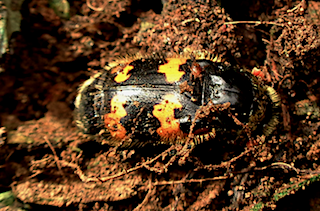 As spring arrives, we can look forward not only to budding flowers, but also to insects, like this Sexton beetle, greeting another year.
As spring arrives, we can look forward not only to budding flowers, but also to insects, like this Sexton beetle, greeting another year.
Photo: Debbie Sea-Kay
Scientific Name: Nicrophorus vespillo
What to look for:
• Colouring and appearance: This is a very distinctive and brightly coloured beetle, with black and orange patterning on the elytra. It can be identified by a combination of orange antennal clubs, an interrupted anterior elytral band, the hind tibia being concave on the inside edge, and the presence of golden hairs on the fore margin of the pronotum.
• Size: 12 to 22 mm
• Where: Various habitats, as it follows the scent of meals as they become available.
• When: Mainly seen in spring and summer, when they are attracted to light.
 This is a large and brightly coloured burying beetle, and one of four species* that are very similarly marked. Nicrophorus vespillo is distinguished by the long golden hairs on the elytra and exposed abdominal segments. Its diet is carrion, which it buries in the ground to provide a food source for the young once they hatch. The burying is usually performed by both male and female, excavating underneath a corpse and covering it with the resulting soil as they go. Eggs are then laid in a chamber by the female.
This is a large and brightly coloured burying beetle, and one of four species* that are very similarly marked. Nicrophorus vespillo is distinguished by the long golden hairs on the elytra and exposed abdominal segments. Its diet is carrion, which it buries in the ground to provide a food source for the young once they hatch. The burying is usually performed by both male and female, excavating underneath a corpse and covering it with the resulting soil as they go. Eggs are then laid in a chamber by the female.
The Sexton beetle is very often a carrier of Gamasidae mites (“phoretic” mites that attach to the host). These mites “hitchhike”, and feed on the carrion collected by the beetle. They do not live at the expense of the beetle, and therefore are not strictly parasites, but the induced discomfort can sometimes be obvious and consistent.
* The four species are as follows. Nicrophorus interruptus: outer lateral edge of the elytron has a black spot at the front; N. vespillo: arched posterior tibias; N. vestigator: first article of the black antennal club and front of the corselet clearly widened; N. vespilloides: our smallest species (12 to 15 mm), clubbed black antennae, posterior orange band reduced to 2 simple spots, quite often found in large rotten agarics.
Did you know…?
…Sexton beetles have a very good sense of smell and are reputed to be able to smell a carcass at up to two miles away.
…Despite being a carrion feeder, it also enjoys eating decomposed mushrooms.
…Sexton beetles are named after church sextons, whose duty it was to look after the graveyard.
…This beetle displays bi-parental care, a rare trait among beetles. For this reason, they are increasingly being used in behavioural research.
…The Sexton beetle can be described as a ‘titan’. It will generally bury a corpse at a depth of 5 to 6c m. If a field mouse weighs approximately 30 g, and the beetle approximately 1 g, this would be the equivalent of a 70 kg man moving 2 tons!
…The female will eat her own larvae if there is insufficient carrion to sustain her offspring.
More information and References:
Sikes, D. S., Madge, R. B., Newton, A. F. (2002). A catalogue of the Nicrophorinae (Coleoptera: Silphidae) of the world. Zootaxa, 65(1).
Published: February 2019
Author: Debbie Sea-Kay
Photo: Debbie Sea-Kay
